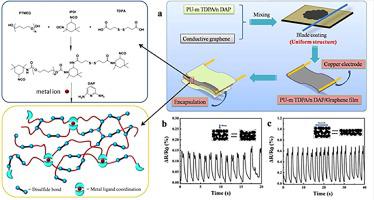European Polymer Journal ( IF 6 ) Pub Date : 2021-09-13 , DOI: 10.1016/j.eurpolymj.2021.110769 Xing Zhou 1 , Hao Wang 1 , Shaonan Li 1 , Mengyue Liu 1

|
Intrinsic self-healing materials designed by combining reversible valence bonds or ionic coordination have attracted much attention due to their ability to recover from mechanical damage. However, their mechanical properties tend to deteriorate due to the increased rigidity of the chain. In this work, we report a self-healing polyurethane elastomer with multiple healing systems. 3,3′-dithiodipropionic acid (TDPA) and iron ion-2,6-diaminopyridine (DAP) were used as dynamic chain extenders and ionic ligands, respectively. They can be effectively unsealed at a certain temperature to ensure that the self-healing efficiency is not affected by the material formula. By changing the content of hard and soft segments, the mechanical properties and self-healing properties of the material can be adjusted in a large range. When the molar ratio of TDPA and DAP is 0.5:0.5, the polyurethane based on multiple healing system only needs to be healed at 70 °C for 12 h, and the self-healing efficiency can reach 93.48%. The structural rigidity and high reversibility of metal complexing agent DAP and iron ions play an important role in enhancing mechanical strength and maintaining self-healing efficiency at 70 °C. Based on the above research, we prepared the strain sensor by combining self-healing polyurethane and conductive graphene. The sensor can respond to external force quickly and stably. This work provides a feasible strategy for the preparation of mechanically robust polyurethane elastomers and self-healing flexible stress sensors with high self-healing efficiency at 70 °C.
中文翻译:

基于多重修复系统的具有高愈合效率和机械性能的自修复弹性体的合成与应用
通过结合可逆价键或离子配位而设计的本征自修复材料因其从机械损伤中恢复的能力而备受关注。然而,由于链条的刚度增加,它们的机械性能趋于恶化。在这项工作中,我们报告了一种具有多种修复系统的自修复聚氨酯弹性体。3,3'-二硫代二丙酸(TDPA)和铁离子-2,6-二氨基吡啶(DAP)分别用作动态扩链剂和离子配体。它们可以在一定温度下有效开封,确保自愈效率不受材料配方的影响。通过改变硬段和软段的含量,可以大范围调节材料的力学性能和自愈性能。当TDPA与DAP的摩尔比为0.5:0.5时,基于多重愈合体系的聚氨酯仅需在70℃下愈合12h,自愈效率可达93.48%。金属络合剂 DAP 和铁离子的结构刚性和高可逆性在增强机械强度和保持 70°C 的自愈效率方面起着重要作用。基于上述研究,我们将自修复聚氨酯和导电石墨烯相结合制备了应变传感器。传感器可以快速稳定地响应外力。这项工作为制备机械坚固的聚氨酯弹性体和在 70°C 下具有高自愈效率的自愈柔性应力传感器提供了一种可行的策略。基于多重愈合体系的聚氨酯仅需在70℃下愈合12h,自愈效率可达93.48%。金属络合剂 DAP 和铁离子的结构刚性和高可逆性在增强机械强度和保持 70°C 的自愈效率方面起着重要作用。基于上述研究,我们将自修复聚氨酯和导电石墨烯相结合制备了应变传感器。传感器可以快速稳定地响应外力。这项工作为制备机械坚固的聚氨酯弹性体和在 70°C 下具有高自愈效率的自愈柔性应力传感器提供了一种可行的策略。基于多重愈合体系的聚氨酯仅需在70℃下愈合12h,自愈效率可达93.48%。金属络合剂 DAP 和铁离子的结构刚性和高可逆性在增强机械强度和保持 70°C 的自愈效率方面起着重要作用。基于上述研究,我们将自修复聚氨酯和导电石墨烯相结合制备了应变传感器。传感器可以快速稳定地响应外力。这项工作为制备机械坚固的聚氨酯弹性体和在 70°C 下具有高自愈效率的自愈柔性应力传感器提供了一种可行的策略。金属络合剂 DAP 和铁离子的结构刚性和高可逆性在增强机械强度和保持 70°C 的自愈效率方面起着重要作用。基于上述研究,我们将自修复聚氨酯和导电石墨烯相结合制备了应变传感器。传感器可以快速稳定地响应外力。这项工作为制备机械坚固的聚氨酯弹性体和在 70°C 下具有高自愈效率的自愈柔性应力传感器提供了一种可行的策略。金属络合剂 DAP 和铁离子的结构刚性和高可逆性在增强机械强度和保持 70°C 的自愈效率方面起着重要作用。基于上述研究,我们将自修复聚氨酯和导电石墨烯相结合制备了应变传感器。传感器可以快速稳定地响应外力。这项工作为制备机械坚固的聚氨酯弹性体和在 70°C 下具有高自愈效率的自愈柔性应力传感器提供了一种可行的策略。传感器可以快速稳定地响应外力。这项工作为制备机械坚固的聚氨酯弹性体和在 70°C 下具有高自愈效率的自愈柔性应力传感器提供了一种可行的策略。传感器可以快速稳定地响应外力。这项工作为制备机械坚固的聚氨酯弹性体和在 70°C 下具有高自愈效率的自愈柔性应力传感器提供了一种可行的策略。



























 京公网安备 11010802027423号
京公网安备 11010802027423号